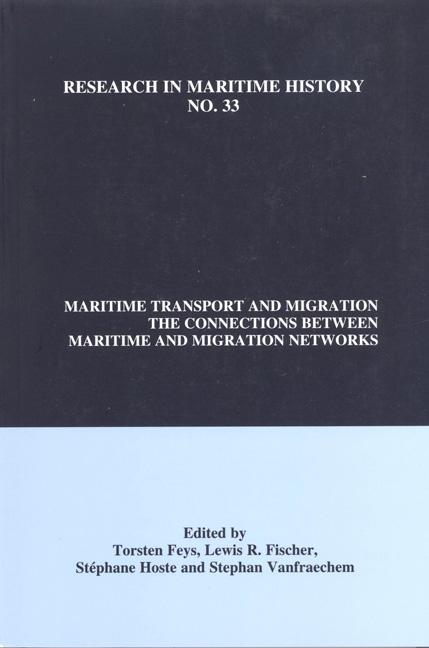Book contents
- Frontmatter
- Contents
- Contributors' Notes
- “Migration and Maritime Networks in the Atlantic Economy: An Introduction”
- “The First Waves of Internationalization: A Comparison of Early Modern North Sea and Nineteenth-Century Transatlantic Labour Migrations”
- “The Battle for the Migrants: The Evolution from Port to Company Competition, 1840-1914”
- “The Role of Foreign-bora Agents in the Development of Mass Migrant Travel through Britain, 1851-1924”
- “Transatlantic Emigration and Maritime Transport from Greece to the US, 1890-1912: A Major Area of European Steamship Company Competition for Migrant Traffic”
- “The ‘Relatives and Friends Effect:’ Migration Networks of Transatlantic Migrants from the Late Habsburg Monarchy”
- “Crossing the Last Frontier: Transatlantic Movements of Asian Maritime Workers, c. 1900-1945”
- “Costs, Risks and Migration Networks between Europe and the United States, 1900-1914”
- “Conclusion”
“Costs, Risks and Migration Networks between Europe and the United States, 1900-1914”
- Frontmatter
- Contents
- Contributors' Notes
- “Migration and Maritime Networks in the Atlantic Economy: An Introduction”
- “The First Waves of Internationalization: A Comparison of Early Modern North Sea and Nineteenth-Century Transatlantic Labour Migrations”
- “The Battle for the Migrants: The Evolution from Port to Company Competition, 1840-1914”
- “The Role of Foreign-bora Agents in the Development of Mass Migrant Travel through Britain, 1851-1924”
- “Transatlantic Emigration and Maritime Transport from Greece to the US, 1890-1912: A Major Area of European Steamship Company Competition for Migrant Traffic”
- “The ‘Relatives and Friends Effect:’ Migration Networks of Transatlantic Migrants from the Late Habsburg Monarchy”
- “Crossing the Last Frontier: Transatlantic Movements of Asian Maritime Workers, c. 1900-1945”
- “Costs, Risks and Migration Networks between Europe and the United States, 1900-1914”
- “Conclusion”
Summary
Migration between Europe and the United States during the period 1900-1914 occurred at the peak of an Atiantic century of open borders, globalization and massive human relocation. About eleven million European migrants entered the US through its four largest ports over the course of these fifteen years, constituting ninety-six percent of all migrants arriving from Europe and sixty percent of all transadantic migrants during this period. The volume of these Adantic traverses fluctuated cyclically but rose over the period as a whole and represents, by any reckoning, one of the greatest and most diverse voluntary mass migrations of all time.
With rare exceptions, however, prior historical investigation into the general causes of this migration has been hampered by inadequate attention to the processes of the organized networks which physically carried out the relocation. The objective here is to redress this imbalance by examining four sets of networks: kinship and community groupings of migrants; steamship agents functioning as travel intermediaries; networks of steamship lines and “conferences;” and the various governmental entities which regulated their businesses and the overall migration. The analysis of the causes of the migration here focuses primarily on the role of risks and costs as intervening obstacles that had to be overcome by the migrants.
Migrants moving en masse to the US from Europe in the early 1900s came in pursuit of what they perceived to be better opportunities. It is not easy to generalize about what those perceptions were, however, in a manner which accounts for both the record number of Europeans choosing to relocate overseas and the even greater number deciding to remain in Europe, while also being applicable across the remarkable ethnic and linguistic diversity of those who did move across the ocean. “Seen through a magnifying glass,” historian Frank Thistlethwaite noted, “this undifferentiated mass surface breaks down into a honeycomb of innumerable particular cells, districts, villages, towns, each with an individual reaction or lack of it to the pull of migration.”
- Type
- Chapter
- Information
- Maritime Transport and MigrationThe Connections Between Maritime and Migration Networks, pp. 113 - 174Publisher: Liverpool University PressPrint publication year: 2007



